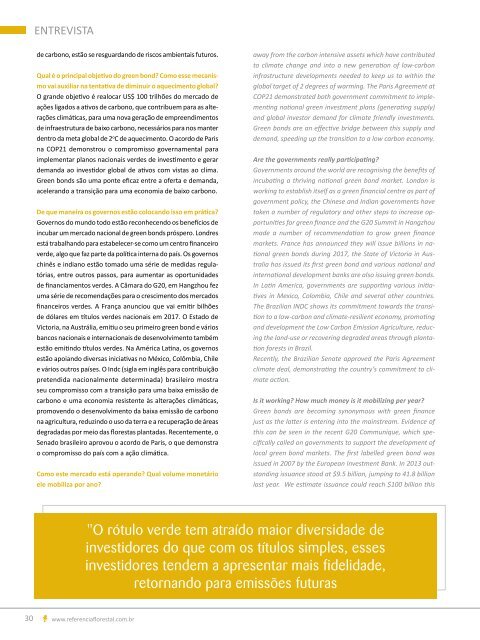Outubro/2016 - Referência Florestal 179
Visitantes - Grupo Jota Comunicação
Visitantes - Grupo Jota Comunicação
Create successful ePaper yourself
Turn your PDF publications into a flip-book with our unique Google optimized e-Paper software.
ENTREVISTA<br />
de carbono, estão se resguardando de riscos ambientais futuros.<br />
Qual é o principal objetivo do green bond? Como esse mecanismo<br />
vai auxiliar na tentativa de diminuir o aquecimento global?<br />
O grande objetivo é realocar US$ 100 trilhões do mercado de<br />
ações ligados a ativos de carbono, que contribuem para as alterações<br />
climáticas, para uma nova geração de empreendimentos<br />
de infraestrutura de baixo carbono, necessários para nos manter<br />
dentro da meta global de 2 o C de aquecimento. O acordo de Paris<br />
na COP21 demonstrou o compromisso governamental para<br />
implementar planos nacionais verdes de investimento e gerar<br />
demanda ao investidor global de ativos com vistas ao clima.<br />
Green bonds são uma ponte eficaz entre a oferta e demanda,<br />
acelerando a transição para uma economia de baixo carbono.<br />
De que maneira os governos estão colocando isso em prática?<br />
Governos do mundo todo estão reconhecendo os benefícios de<br />
incubar um mercado nacional de green bonds próspero. Londres<br />
está trabalhando para estabelecer-se como um centro financeiro<br />
verde, algo que faz parte da política interna do país. Os governos<br />
chinês e indiano estão tomado uma série de medidas regulatórias,<br />
entre outros passos, para aumentar as oportunidades<br />
de financiamentos verdes. A Câmara do G20, em Hangzhou fez<br />
uma série de recomendações para o crescimento dos mercados<br />
financeiros verdes. A França anunciou que vai emitir bilhões<br />
de dólares em títulos verdes nacionais em 2017. O Estado de<br />
Victoria, na Austrália, emitiu o seu primeiro green bond e vários<br />
bancos nacionais e internacionais de desenvolvimento também<br />
estão emitindo títulos verdes. Na América Latina, os governos<br />
estão apoiando diversas iniciativas no México, Colômbia, Chile<br />
e vários outros países. O Indc (sigla em inglês para contribuição<br />
pretendida nacionalmente determinada) brasileiro mostra<br />
seu compromisso com a transição para uma baixa emissão de<br />
carbono e uma economia resistente às alterações climáticas,<br />
promovendo o desenvolvimento da baixa emissão de carbono<br />
na agricultura, reduzindo o uso da terra e a recuperação de áreas<br />
degradadas por meio das florestas plantadas. Recentemente, o<br />
Senado brasileiro aprovou o acordo de Paris, o que demonstra<br />
o compromisso do país com a ação climática.<br />
Como este mercado está operando? Qual volume monetário<br />
ele mobiliza por ano?<br />
away from the carbon intensive assets which have contributed<br />
to climate change and into a new generation of low-carbon<br />
infrastructure developments needed to keep us to within the<br />
global target of 2 degrees of warming. The Paris Agreement at<br />
COP21 demonstrated both government commitment to implementing<br />
national green investment plans (generating supply)<br />
and global investor demand for climate friendly investments.<br />
Green bonds are an effective bridge between this supply and<br />
demand, speeding up the transition to a low carbon economy.<br />
Are the governments really participating?<br />
Governments around the world are recognising the benefits of<br />
incubating a thriving national green bond market. London is<br />
working to establish itself as a green financial centre as part of<br />
government policy, the Chinese and Indian governments have<br />
taken a number of regulatory and other steps to increase opportunities<br />
for green finance and the G20 Summit in Hangzhou<br />
made a number of recommendation to grow green finance<br />
markets. France has announced they will issue billions in national<br />
green bonds during 2017, the State of Victoria in Australia<br />
has issued its first green bond and various national and<br />
international development banks are also issuing green bonds.<br />
In Latin America, governments are supporting various initiatives<br />
in Mexico, Colombia, Chile and several other countries.<br />
The Brazilian INDC shows its commitment towards the transition<br />
to a low-carbon and climate-resilient economy, promoting<br />
and development the Low Carbon Emission Agriculture, reducing<br />
the land-use or recovering degraded areas through plantation<br />
forests in Brazil.<br />
Recently, the Brazilian Senate approved the Paris Agreement<br />
climate deal, demonstrating the country’s commitment to climate<br />
action.<br />
Is it working? How much money is it mobilizing per year?<br />
Green bonds are becoming synonymous with green finance<br />
just as the latter is entering into the mainstream. Evidence of<br />
this can be seen in the recent G20 Communique, which specifically<br />
called on governments to support the development of<br />
local green bond markets. The first labelled green bond was<br />
issued in 2007 by the European Investment Bank. In 2013 outstanding<br />
issuance stood at $9.5 billion, jumping to 41.8 billion<br />
last year. We estimate issuance could reach $100 billion this<br />
"O rótulo verde tem atraído maior diversidade de<br />
investidores do que com os títulos simples, esses<br />
investidores tendem a apresentar mais fidelidade,<br />
retornando para emissões futuras<br />
30<br />
www.referenciaflorestal.com.br

















